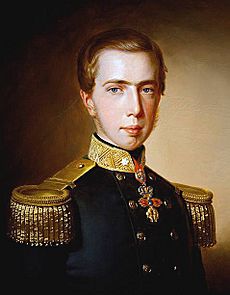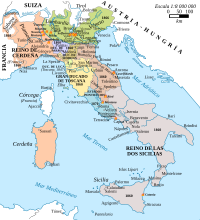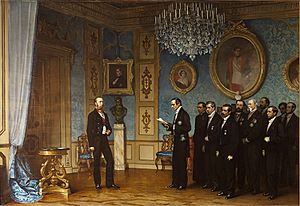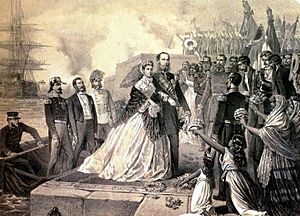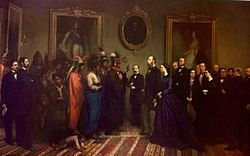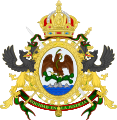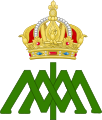Maximilian I of Mexico facts for kids
Quick facts for kids Maximilian I |
|||||
|---|---|---|---|---|---|
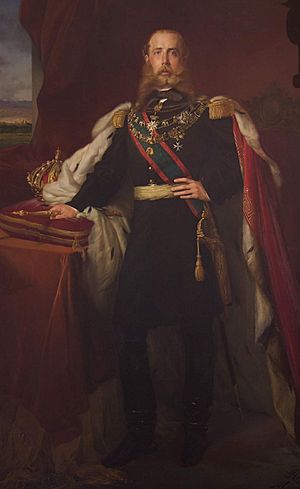
Portrait by Santiago Rebull, c. 1865
|
|||||
| Emperor of Mexico | |||||
| Reign | 10 April 1864 – 19 June 1867 | ||||
| Predecessor | Agustin I | ||||
| Successor | Agustin de Iturbide (disputed) | ||||
| Prime ministers |
See list
José Lacunza
Teodosio Lares Santiago Vidaurri |
||||
| Born | 6 July 1832 Schönbrunn Palace, Vienna, Austrian Empire |
||||
| Died | 19 June 1867 (aged 34) Cerro de las Campanas, Santiago de Querétaro, Mexican Empire |
||||
| Burial | 18 January 1868 Imperial Crypt, Vienna, Austria |
||||
| Spouse | |||||
|
|||||
| House | Habsburg-Lorraine | ||||
| Father | Archduke Franz Karl of Austria | ||||
| Mother | Princess Sophie of Bavaria | ||||
| Religion | Roman Catholicism | ||||
| Signature | |||||
Maximilian I (born Ferdinand Maximilian Josef Maria von Habsburg-Lothringen; 6 July 1832 – 19 June 1867) was an Austrian archduke. He became the emperor of the Second Mexican Empire on 10 April 1864. His rule ended when he was executed by the Mexican Republic on 19 June 1867.
Maximilian was a member of the House of Habsburg-Lorraine. He was the younger brother of Emperor Franz Joseph I of Austria. Before becoming emperor of Mexico, he was the commander of the Imperial Austrian Navy. He also served as the Austrian viceroy of Lombardy–Venetia, a region in Italy. He tried to calm nationalist feelings there but was removed from his post in 1859.
Around this time, he met Napoleon III, the French emperor. Mexican monarchists (people who wanted a king or emperor) were looking for a European royal to rule Mexico. They saw Maximilian as a good choice because he was a descendant of Charles V, Holy Roman Emperor. Charles V had ruled Spain when it conquered the Aztecs and brought Mexico into the Spanish Empire.
Maximilian was interested in the idea, but he wanted France to promise military support. Mexican conservatives, who supported him, didn't fully understand that Maximilian had liberal ideas. Maximilian, on the other hand, didn't realize how much Mexicans would dislike a foreign ruler.
In the 1850s, Mexico had a civil war between conservatives and liberals. The liberals won and created a new constitution in 1857. This constitution limited the power of the Catholic Church and the army. Conservatives didn't like this and rebelled, but they lost the war.
In 1861, the Mexican government, led by President Benito Juárez, stopped paying its foreign debts. This gave European countries a reason to get involved. France, Spain, and the United Kingdom sent forces to Mexico. Spain and Britain soon left after making agreements. They realized France, with Mexican conservatives, wanted to change the government.
Mexican conservatives, with help from Emperor Napoleon III, invited Maximilian to become emperor. This led to the Second Mexican Empire. Maximilian accepted the crown on 10 April 1864, with French military support.
Several European countries recognized the Mexican Empire. However, the United States did not. It continued to support Benito Juárez's republican government. The U.S. saw the French invasion as a violation of the Monroe Doctrine, which stated that European powers should not interfere in the Americas. The U.S. was busy with its own civil war at the time, so it couldn't intervene directly.
French and Mexican Imperial forces never fully defeated the Mexican Republic. Juárez's government was weak but never left the country. Republican fighters continued to resist. After the American Civil War ended in 1865, the U.S. began helping Juárez's forces. French armies started to leave Mexico in 1866.
Without French support and with little popular backing, Maximilian's empire was doomed. He was captured after a final stand at Querétaro. He was tried and executed by the restored Republican government in June 1867. His generals, Miguel Miramón and Tomás Mejía Camacho, were executed with him.
Contents
Early Life and Education
Maximilian was born on 6 July 1832 at the Schönbrunn Palace in Vienna, the capital of the Austrian Empire. He was named Ferdinand Maximilian Josef Maria. His father was Archduke Franz Karl of Austria, and his mother was Princess Sophie of Bavaria. This made him a member of the House of Habsburg-Lorraine.
Sophie was intelligent and strong-willed. Maximilian's education was carefully planned. He studied many subjects, including history, geography, law, technology, languages, and military studies. From a young age, he tried to be better than his older brother, Franz Joseph I of Austria. However, Franz Joseph was older, so he was destined to be emperor.

Maximilian was a joyful and charming boy. He could easily win people over. But he was also a bit undisciplined and liked to play pranks. Despite this, he was popular. His efforts to outshine his brother created a distance between them that grew over the years.
In 1848, there were revolutions across Europe. Emperor Ferdinand gave up his throne to Maximilian's brother, Franz Joseph. Maximilian went with his brother to help stop rebellions. He was horrified by the harsh punishments given to rebels. He believed it was "senseless brutality."
Maximilian was a clever boy who loved the arts and science, especially plants. He joined the Imperial Austrian Navy. He was very enthusiastic about his naval career. His connection to the emperor helped bring more money to the navy, which had been overlooked before.
He sailed on several trips, including a cruise through Greece. In 1851, he went on a longer voyage aboard the SMS Novara. He loved this trip, writing in his diary about fulfilling his dream of traveling by sea.
This journey took him to Lisbon, Portugal. There, he met Princess Maria Amélia of Braganza, daughter of the late Brazilian Emperor Pedro I. They fell in love. Sadly, Maria Amélia became ill and died in February 1853. This deeply affected Maximilian.
He continued his naval career, learning to command sailors and understand navigation. On 10 September 1854, he became Commander in Chief of the Austrian Navy and was given the rank of counter admiral. He visited places like Beirut, Palestine, and Egypt.
As commander-in-chief, Maximilian made many changes to modernize the navy. He helped create naval ports at Trieste and Pola (now Pula). He also started a large scientific expedition (1857–1859). During this trip, the frigate SMS Novara became the first Austrian warship to sail around the world.
In 1855, he found shelter for his ship in the Gulf of Trieste during bad weather. He was so impressed that he decided to build a home there. Construction of Miramare Castle began in March 1856 near Trieste.
After the Crimean War ended in 1856, Maximilian traveled to Paris. He met Emperor Napoleon III and Empress Eugénie of France. He also met Mexican conservatives there, who would later play a big role in his life.
Marriage to Charlotte of Belgium
In May 1856, Maximilian visited Brussels and met Charlotte of Belgium. She was the only daughter of King Leopold I. They fell in love, and Leopold I encouraged Maximilian to propose. Maximilian had been unlucky in love before, so this marriage to a European princess seemed like a happy ending.
Their engagement was announced on 23 December 1856. Maximilian and Charlotte were married on 27 July 1857 in Brussels. Many important European royals attended, including Prince Albert, Queen Victoria's husband and Charlotte's cousin. This marriage helped boost the standing of Belgium's new royal family.
Maximilian and Charlotte did not have any biological children. Later, when they were Emperor and Empress of Mexico, they adopted two grandsons of Agustín de Iturbide, who had been a brief emperor of Mexico. These adopted children were Agustín de Iturbide y Green and his cousin Salvador de Iturbide y Marzán. They were given royal titles. However, as the Empire began to fail, Maximilian returned Agustín to his mother.
Viceroy of Lombardy-Venetia
On 28 February 1857, Maximilian was named viceroy of Lombardy-Venetia. This was an Italian-speaking part of the Austrian Empire. Maximilian and Charlotte arrived in the capital, Milan, on 6 September 1857. They lived at the Royal Palace of Milan.
As viceroy, Maximilian lived like a ruler with a large court. He continued building Miramar Castle, using money from Charlotte's dowry. He also worked on improving the imperial navy and organized the Novara scientific expedition.
Maximilian was influenced by liberalism, which was unusual for a royal at that time. He was appointed viceroy to try and calm the growing unhappiness of the Italian people. Charlotte tried to win over the people by speaking Italian, visiting charities, and opening schools.
Despite their efforts, anti-Austrian feelings continued to grow. Maximilian tried to improve the region by changing tax rules, building medical centers, and improving canals and ports. He also started urban development projects in Milan and Venice. A British minister said in 1859 that Maximilian's rule was "with great talent, and both a liberal and conciliatory spirit."
Dismissal as Viceroy
Maximilian's time as viceroy was short, lasting only two years. He didn't have full control over the Austrian army in the region, which opposed his liberal ideas. He asked his brother, Emperor Franz Joseph, for more power, but Franz Joseph refused.
Tensions were rising in Italy. In February 1859, the Austrian military cracked down, making many arrests. Maximilian tried to soften these harsh actions. However, Franz Joseph thought Maximilian was too liberal. So, on 10 April 1859, Franz Joseph removed his brother from the post of viceroy.
Emperor of Mexico
Becoming Emperor
After gaining independence in 1821, Mexico was divided between liberals and conservatives. Some conservatives wanted a monarchy. In 1840, a statesman named José María Gutiérrez de Estrada suggested inviting a European prince to rule Mexico.
Mexican diplomat José Hidalgo worked to find a European royal. He had a friend, Eugénie de Montijo, who was now the wife of Napoleon III, Emperor of France. Through her, Hidalgo got Napoleon III's attention.
Maximilian's name came up as a possible emperor. He was seen as a good choice because his family, the Habsburgs, had ruled Mexico (as New Spain) before. Also, he had a reputation as a good administrator from his time as viceroy. In 1859, Mexican monarchists first asked Maximilian to be emperor. He declined then, but they kept trying.
By 1861, the United States was fighting its own Civil War. This meant it couldn't stop European countries from interfering in Mexico. In July 1861, Mexican President Benito Juárez stopped paying foreign debts. This gave France, Britain, and Spain a reason to intervene. They met at the Convention of London to plan an expedition.
Maximilian said he would accept the throne if two things happened: first, Mexico itself had to ask him to rule. Second, he needed support from France and Great Britain.
The agreement between France, Britain, and Spain broke down. It became clear that France wanted to overthrow Juárez's government. France began military operations in April 1862. They were joined by Mexican conservatives. After some fighting, French forces took Mexico City in June 1863.
The French then set up a committee of Mexicans who invited Maximilian to be Emperor. Maximilian said he would only accept if the Mexican people approved. By February 1864, French and Mexican Imperial forces controlled most of Mexico. A vote was held, which claimed that most Mexicans supported the Empire. Maximilian accepted.
On 9 April 1864, Maximilian signed a "Family Pact" with his brother, Emperor Francis Joseph. In this document, Maximilian gave up his rights to the Austrian throne. He formally accepted the crown of Mexico on 10 April 1864 and sailed for his new country.
Arrival and Rule in Mexico
In April 1864, Maximilian left his naval duties. He sailed from Trieste on the SMS Novara. He received a blessing from Pope Pius IX.
Maximilian landed at Veracruz on 29 May 1864. The town had a yellow fever outbreak, so his welcome was quiet. But his arrival in Mexico City was celebrated with fireworks. Maximilian and Charlotte were crowned at the Cathedral of Mexico City.
He had the support of Mexican conservatives, the church, and some native groups. But President Benito Juárez and his liberal forces refused to recognize his rule. There was constant fighting between French and Imperial Mexican troops against the Mexican Republicans.
Maximilian and Charlotte decided to live at Chapultepec Castle, which was on a hill outside Mexico City. It had been a retreat for Aztec emperors and Spanish viceroys. Maximilian ordered a wide avenue to be built from Chapultepec to the city center. He named it the Paseo de la Emperatriz. Today, it is a main avenue in Mexico City called the Paseo de la Reforma.
Maximilian offered a political pardon to all liberals who wanted to join his Empire. He tried to win over moderate liberals. He even offered Juárez the post of prime minister, but Juárez refused. Maximilian focused on reorganizing his government and army.
During his short rule, Maximilian issued many laws. These covered things like railroads, postal services, mining, and immigration. He also made laws to protect the rights of Mexicans, especially native people. He tried to ensure native people earned a fair wage and outlawed harsh punishments for them. He also planned a system of free schools. Laws were published in Spanish and Nahuatl, the Aztec language.
Maximilian also created an agency to encourage people to move to Mexico from the United States, Europe, and Asia. New settlers were given citizenship and tax breaks.
In August 1864, Maximilian traveled through Mexico while Charlotte was regent. He visited cities and met officials. He celebrated Mexican independence in the town where it began. Charlotte took a similar trip in late 1865.
Court Life
Maximilian mostly lived at Chapultepec Castle. He enjoyed the Mexican countryside, often riding horses, walking, and swimming. On Sundays, he and Charlotte often met with people from all parts of society, including Mexico's Indigenous Communities. They also hosted many balls for Mexican high society.
Empire's Decline
In April 1865, the American Civil War ended. The U.S. government refused to recognize Maximilian's Empire. It continued to support Juárez. The U.S. also approved a large loan for Juárez and American volunteers joined the Mexican republican troops.
The U.S. put diplomatic pressure on France to leave Mexico. French troops in Mexico were fighting many republican groups. In October, Maximilian signed a harsh decree. It allowed the execution of anyone helping or fighting with the republican forces. This was called the Black Decree and made the Empire very unpopular. More than eleven thousand of Juárez's supporters were executed because of it.
In January 1866, Napoleon III decided to withdraw French troops from Mexico. Maximilian asked for more help, but it was refused. Charlotte traveled to Europe to plead for the Empire's cause. But she couldn't get more support. The failure of her mission caused her to become very ill. She spent the rest of her life in Belgium.
Fall of the Empire
In October 1866, Maximilian considered leaving Mexico. But his ministers voted against it. He decided to try and hold a national assembly to decide Mexico's future government. However, Juárez refused to agree to a ceasefire.
As the assembly plan failed, Maximilian focused on military operations. In February, as the last French troops left, he went to Querétaro to join his Mexican troops. Republican generals Escobedo and Corona surrounded Querétaro with many more men.
On 11 May, Maximilian tried to escape. But a colonel named Miguel López betrayed him, opening the city gates to the Republicans. The city fell on 15 May 1867. Maximilian was captured the next morning along with his generals Mejía and Miramon.
Execution
Maximilian's trial began on 13 June. He was accused of trying to overthrow the Mexican government and for the Black Decree. His lawyers argued that his rule was legitimate and benevolent. After only one day, the court found him guilty and sentenced him to death.
Many European leaders and important figures asked Mexico to spare Maximilian's life. However, Juárez refused. He believed it was necessary to show that Mexico would not allow foreign interventions.
Maximilian was executed by a firing squad on 19 June 1867, at 6:40 a.m., at the Cerro de las Campanas. Generals Miramón and Mejía were executed with him. He spoke only in Spanish. His last words were, "I forgive everyone, and I ask everyone to forgive me. May my blood which is about to be spilled end the bloodshed which has been experienced in my new motherland. Long live Mexico! Long live its independence!"
After his death, Maximilian's body was embalmed. The Austrian admiral Wilhelm von Tegetthoff took his body back to Austria on the SMS Novara. He was buried in the Imperial Crypt in Vienna on 18 January 1868. The Emperor Maximilian Memorial Chapel was built where he was executed.
Cultural Depictions
Maximilian's execution was shown in paintings by French artist Édouard Manet. Photographs of his bullet-ridden shirt circulated after his death.
Composer Franz Liszt wrote a funeral march in his memory. In Vienna, items belonging to Maximilian are displayed at the Schatzkammer Museum. A statue of Maximilian stands near the Schönbrunn Palace Park.
In Italy, a statue of Maximilian is in Trieste.
Maximilian has been portrayed in plays, films, and television. The play Juarez and Maximilian focuses on him and Juárez. In films, he has been played by actors like Brian Aherne and Mario Iván Martínez.
Legacy
Some historians praise Maximilian for his liberal reforms. They say he truly wanted to help the people of Mexico. Others see him as short-sighted in politics and military matters.
In Mexico, there are no statues of Maximilian. However, the Emperor Maximilian Memorial Chapel stands where he and his generals were executed. Some anti-republican groups gather there each year to remember his execution.
The closest living relative to Maximilian from the Habsburg family is Karl von Habsburg. Members of the House of Habsburg-Lorraine still live in Mexico today.
Honours
- Foreign
 Austrian Empire:
Austrian Empire:
- Knight of the Golden Fleece, 1852
- Grand Cross of the Royal Hungarian Order of St. Stephen, 1856
 Baden:
Baden:
- Knight of the House Order of Fidelity, 1856
- Grand Cross of the Zähringer Lion, 1856
 Kingdom of Bavaria: Knight of St. Hubert, 1849
Kingdom of Bavaria: Knight of St. Hubert, 1849 Belgium: Grand Cordon of the Order of Leopold, 20 May 1853
Belgium: Grand Cordon of the Order of Leopold, 20 May 1853 Empire of Brazil: Grand Cross of the Southern Cross
Empire of Brazil: Grand Cross of the Southern Cross Brunswick: Grand Cross of the Order of Henry the Lion
Brunswick: Grand Cross of the Order of Henry the Lion Denmark: Knight of the Elephant, 11 January 1866
Denmark: Knight of the Elephant, 11 January 1866 French Empire: Grand Cross of the Legion of Honour
French Empire: Grand Cross of the Legion of Honour Kingdom of Greece: Grand Cross of the Redeemer
Kingdom of Greece: Grand Cross of the Redeemer Kingdom of Hanover:
Kingdom of Hanover:
- Knight of St. George, 1856
- Grand Cross of the Royal Guelphic Order, 1856
 Grand Duchy of Hesse:
Grand Duchy of Hesse:
- Grand Cross of the Ludwig Order, 11 May 1856
- Grand Cross of the Merit Order of Philip the Magnanimous, 1856
 Holy See:
Holy See:
- Grand Cross of the Order of Pope Pius IX
- Knight of the Collar of the Holy Sepulchre
 Kingdom of Italy: Knight of the Annunciation, 29 March 1865
Kingdom of Italy: Knight of the Annunciation, 29 March 1865 Sovereign Military Order of Malta: Bailiff Grand Cross of Honour and Devotion
Sovereign Military Order of Malta: Bailiff Grand Cross of Honour and Devotion Netherlands: Grand Cross of the Netherlands Lion, 8 June 1856
Netherlands: Grand Cross of the Netherlands Lion, 8 June 1856 Kingdom of Portugal: Grand Cross of the Tower and Sword, 14 June 1852
Kingdom of Portugal: Grand Cross of the Tower and Sword, 14 June 1852 Kingdom of Prussia:
Kingdom of Prussia:
- Knight of the Black Eagle, 21 December 1852; with Collar, 13 January 1866
- Grand Cross of the Red Eagle, 21 December 1852
 Russian Empire:
Russian Empire:
- Knight of St. Andrew
- Knight of St. Alexander Nevsky
- Knight of the White Eagle
- Knight of St. Anna, 1st Class
- Knight of St. Stanislaus, 1st Class
 Kingdom of Saxony: Knight of the Rue Crown, 1852
Kingdom of Saxony: Knight of the Rue Crown, 1852
 Sweden-Norway: Knight of the Seraphim, with Collar, 21 April 1865
Sweden-Norway: Knight of the Seraphim, with Collar, 21 April 1865 Grand Duchy of Tuscany: Grand Cross of St. Joseph
Grand Duchy of Tuscany: Grand Cross of St. Joseph Two Sicilies
Two Sicilies
- Grand Cross of St. Ferdinand and Merit
- Knight of St. Januarius
Arms
See also
 In Spanish: Maximiliano de México para niños
In Spanish: Maximiliano de México para niños


